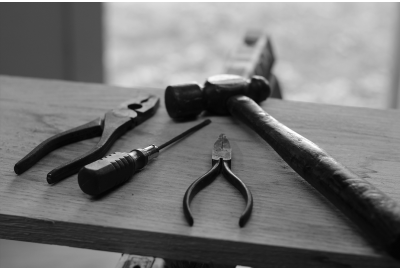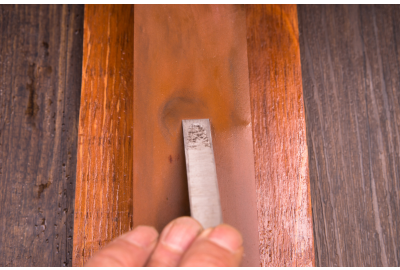Bench vices are indispensable tools designed to hold and compress objects made of different materials like wood or metal securely.
Often found in car garages, carpenter's workshops, and locksmiths, these versatile tools come in various types, each offering distinct widths and tightening capabilities.
Choosing the correct bench vice is crucial for specific tasks, and this blog is here to guide you in purchasing a bench vice that perfectly aligns with your needs.
Whether you're a carpenter working with wood or a metalworker shaping metals, understanding the range of options available and their respective features will help you to make an informed decision.
What are the common types of bench vice?
When selecting the ideal bench vice for your workshop, understanding the diverse options available is crucial for achieving optimal results in various tasks.
Bench vices come in several specialised types, each tailored to specific applications.
Woodworking vices are designed with non-marring jaws, perfect for delicate wood projects that demand precision and care. On the other hand, metalworking vices boast sturdy construction and serrated steel jaws, providing a secure grip for heavy-duty metal tasks.
Multi-purpose vices offer versatility with replaceable jaws, catering to various materials and projects.
Engineer's vices, built for robust metalwork, are the go-to choice for heavy-duty applications.
Quick-release vices facilitate rapid adjustments, saving time and enhancing efficiency in fast-paced projects.
Pipe vices, specialised for gripping cylindrical objects, play a crucial role in plumbing and related applications.
The classification of bench vices extends further to categories like heavy duty, light duty, fixed, and those with a swivel base, offering users a spectrum of choices based on their specific needs.
Let’s delve into further detail about these different types of vices.
Pipe Vice
A pipe vice has a purposeful design tailored to the unique demands of working with cylindrical objects, particularly pipes.
Central to its functionality is the V-shaped jaws, strategically crafted to deliver a secure and steadfast grip on the rounded surfaces of pipes. This prevents any unwanted rolling or slipping during cutting, threading, or shaping tasks, thereby ensuring the operator's safety and the workpiece's integrity.
Widely embraced across various industries, including plumbing and metalworking, the pipe vice is an indispensable tool in trades where the manipulation of pipes is a routine necessity.
Its significance lies not only in its ability to hold cylindrical materials firmly but also in its contribution to stability and control during intricate procedures.
By providing a reliable anchor for pipes, this type of bench vice streamlines the execution of precise and accurate work, allowing professionals to achieve superior results in their craft.
Machine Vice
A machine vice is used in machining operations to hold workpieces securely. It differs from other vices as the user can typically mount it to machine tools like milling machines or drill presses instead of fixing it to a workbench.
With its versatility in accommodating various workpiece shapes and sizes, the machine vice is helpful in diverse industrial applications, ensuring stability and precision during cutting, milling, or drilling tasks.
Woodworking Vice
The woodworking vice secures woodwork pieces during a spectrum of tasks.
Crafted with a meticulous understanding of the delicate nature of wood, this vice is equipped with wooden or soft jaws to prevent any potential damage to the surface of the wood.
Woodworking vices often feature a quick-release mechanism, allowing for efficient and swift adjustments. This characteristic enhances the convenience of use, contributing to the overall efficiency of woodworking projects.
In the hands of craftsmen and hobbyists alike, the woodworking vice becomes an essential partner in tasks such as sawing, planing, or carving. Its stability and control during these processes ensure the precision and finesse required for crafting intricate wooden pieces.
Metalworking Vice
A metalworking vice is a specialised bench vice meticulously crafted for the rigorous demands of holding and securing metal workpieces during various metalworking processes.
Its construction often involves robust materials such as cast iron, instilling durability and stability into the very core of its design. Most metalworking vices have serrated steel jaws engineered to deliver a powerful and secure grip on metal materials.
Whether in a professional metalworking shop or a hobbyist's garage, a metalworking vice is an indispensable tool.
Chain Vice
A chain vice is designed to address the unique challenges of working with pipes and cylindrical objects in plumbing and metalworking applications. Its innovative use of a chain mechanism to securely grip and hold pipes during various operations sets this vice apart.
This design proves particularly effective when undertaking tasks like threading or cutting pipes, as the chain ensures a reliable and steadfast grip, minimising the risk of slippage and providing stability throughout these intricate operations.
What are the different parts of a bench vice?
Below are the main features typically found on a bench vice.
Base
Positioned at the lowermost part and securely attached to the workbench or a similar surface, the base provides the stability necessary for the vice to perform its functions effectively. Its firm attachment to the workbench ensures that the vice remains steadfast during clamping and machining operations.
The design of the base can vary based on the type of bench vice, with some featuring mounting holes or other elements facilitating easy installation on a work surface.
The stability of the base is essential as it directly influences the overall performance and safety of the bench vice. Whether it's woodworking, metalworking, or other tasks, the reliability of the base ensures that the vice remains a reliable and secure tool.
Spindle
Functioning as a threaded rod running vertically through the body of the vice, the spindle acts as the linchpin that connects to the handle.
When the handle is turned, the spindle is set in motion either forward or backwards, thereby orchestrating the synchronised movement of the jaws, i.e. bringing them together or apart.
This simple yet effective mechanism enables users to swiftly and precisely adjust the width of the vice jaws, accommodating an array of workpiece sizes. The spindle's pivotal role is underscored in its capacity to provide the means for clamping and securing materials during a myriad of tasks.
Fixed Jaw
Typically featuring a flat or serrated surface, the fixed jaw ensures a secure grip on the workpiece, which is vital for tasks such as machining, woodworking, or any other application where a bench vice is employed.
Its unyielding position provides a stable foundation, contributing to the overall accuracy and control necessary for intricate projects.
Handle
The handle of a bench vice provides the means to control the vice jaws' movement manually.
Affixed to the spindle, the handle becomes the lever through which users exert control over the rotation of the spindle. By turning the handle, the spindle either advances or retracts, causing the unfixed jaw to move toward or away from the fixed jaw.
This simple yet effective mechanism enables users to adjust the width of the vice jaws swiftly and precisely, facilitating the clamping or releasing of workpieces with ease.
Movable Jaw
Connected to the spindle, a moveable jaw allows a vice to accommodate different sizes of workpieces.
As mentioned, when the handle is turned, the spindle moves, prompting the movable jaws to adjust their position toward or away from the fixed jaws.
This pivotal mechanism enables the movable jaws to grip the workpiece securely, providing a reliable means of clamping and holding it during various tasks such as cutting, drilling, or shaping.
A moveable jaw can have a flat or serrated surface to enhance grip and stability, ensuring the workpiece remains firmly in place. We will provide more details on this in the next section.
The ability to adjust the movable jaws imparts a high degree of flexibility to the bench vice, making it adaptable to diverse workpiece sizes and shapes.
Jaw Plate
The jaw plates on a bench vice define the tool's functionality and are directly responsible for gripping and securing the workpiece.
These plates on both the fixed and movable jaws come in different configurations tailored to meet specific needs.
Flat jaw plates are ideal for general use, providing a stable and even grip across various materials. Conversely, serrated jaw plates are designed to enhance grip on tougher materials, preventing slippage during tasks such as cutting or shaping.
Additionally, specialised jaw plates are crafted to grip cylindrical objects like pipes precisely.
The choice of jaw plates becomes a crucial consideration, dictated by the nature of the task and the material at hand.
What you Need to Consider when Buying a Bench Vice
It’s essential to fully consider your task and what you’ll need from your bench vice. Below are some aspects to consider before acquiring a bench vice.
1) Determine what you are using the bench vice for
Whether you are working with wood or metal, engaging in adhesive tasks like glueing, or undertaking specific applications like conduit cutting, you must acquire a bench vice that suits your task.
2) Understand what type you require
Heavy-Duty Vice
A heavy-duty vice is a robust and resilient tool specifically engineered to meet the challenges of demanding applications that involve extensive or dense materials.
This type of vice is typically constructed using rugged materials like cast iron, which imparts substantial strength and ensures stability in the face of formidable tasks.
Its design is tailored to deliver an elevated level of clamping force, making it exceptionally well-suited for heavy-duty applications such as metal fabrication and welding.
A heavy-duty vice can withstand intense use and tackle formidable materials, making it a vital tool for workshops and industrial settings.
Medium-Duty Vice
Designed to handle woodworking, metalworking, and general-purpose applications, a medium-duty vice strikes a balance between strength and adaptability.
While it may not boast the sheer robustness of heavy-duty vices, it offers a practical compromise for users seeking a durable and versatile tool that can adeptly navigate various projects.
3) Jaw opening width
When selecting a vice for your workshop, it's imperative to carefully consider its dimensions, each determining its suitability for specific tasks.
The jaw width, representing the distance between the inner surfaces of the vice jaws, dictates the maximum size of the workpiece that the vice can effectively grip.
A broader jaw width accommodates larger materials, offering greater flexibility in handling various projects.
Throat depth, on the other hand, measures the distance from the top of the jaws to the base of the vice, providing insight into how deep a workpiece can be securely clamped.
A deeper throat depth is advantageous for securing longer or bulkier materials.
Opening capacity refers to the maximum distance the jaws can open, indicating the range of workpiece sizes the vice can accommodate.
Understanding and considering these dimensions enables users to make informed decisions, ensuring that the chosen vice aligns precisely with the demands of their specific projects.
4) Jaw type and material
As mentioned, bench vices come with different jaw types, each tailored to address unique challenges in various applications.
Pipe jaws, for instance, are meticulously designed for gripping cylindrical objects, offering a secure and stable hold during plumbing or metalworking operations.
On the other hand, serrated jaws present a robust solution, providing a firmer grip that effectively prevents slippage, making them indispensable in tasks such as metalworking or machining where stability is paramount.
Conversely, flat jaws emerge as versatile, general-purpose components, ideal for safely and precisely holding flat or evenly shaped workpieces.
5) Vice rotation
Regarding bench vices, the term "rotation" encompasses a spectrum of adjustments and positioning options that significantly enhance the tool's versatility.
A notable feature is the 360-degree swivel base, allowing the entire vice to rotate horizontally. This lets users position the workpiece at various angles, offering unparalleled flexibility during tasks.
Vertical rotation, controlled by the vice handle, involves the movable jaw's standard opening and closing motion connected to the spindle, accommodating different workpiece sizes.
Another valuable aspect is angular rotation, a feature in some vices that allows the jaws to be tilted or angled. This capability proves invaluable for securely holding irregularly shaped workpieces.
6) Cast or Forged
The choice between cast and forged bench vices hinges on the manufacturing processes of crafting these tools.
Cast vices are formed by pouring molten metal, typically cast iron, into a mould, shaping the various components of the vice. This process makes cast vices more economically viable and suitable for a broad range of tasks, although they may exhibit a slightly rougher finish compared to their forged counterparts.
Forged vices are crafted through force, often hammering or pressing hot metal into the desired form. The forging process imparts exceptional strength and durability to these vices by aligning the metal's internal grain structure, making them tougher and more resilient.
While cast vices are often preferred for general-purpose applications due to their cost-effectiveness, forged vices are renowned for their superior strength, making them the go-to choice for tasks that demand the utmost durability and robustness.
Ultimately, the decision between cast and forged vices depends on the specific requirements of the projects, whether the affordability and versatility of cast vices or the unmatched strength and resilience of their forged counterparts.
7) Mounting
Selecting the right mounting style for your bench vice is a crucial decision directly impacting its functionality and adaptability to various tasks.
Bolt-on vices offer a permanent and secure attachment to the workbench, providing stability for tasks that require a steadfast grip and precision.
On the other hand, clamp-on bench vices offer portability and flexibility, allowing users to move and reposition the vice across different work areas easily.
The choice between the two depends on the specific needs of your projects. If flexibility in positioning is paramount, especially when dealing with varying workpiece sizes and shapes, consider opting for a vice with a swivel base.
8) Weight
When selecting a bench vice, particularly if you anticipate clamping something large or heavy, assess the tool's weight-bearing capacity to ensure suitability for your tasks.
A thorough examination of the vice's maximum load capacity allows you to gauge whether it can securely and effectively hold the needed materials.
Whether you're working in a woodworking shop, metal fabrication, or any other industrial setting, considering the vice's weight and load capacity is a foundational step in selecting the right tool for the job, promoting efficiency, safety, and optimal performance in your work.
9) Choosing a reliable manufacturer
If you are planning DIY projects that require a bench vice, purchase from a reliable company, such as Heamar.
Selecting a reliable, high-quality manufacturer for a bench vice ensures durability, precision, and performance, which are vital for safe and effective clamping in various tasks.
We are a trustworthy company known for offering an extensive range of high-quality tools, from vices and clamps to power tools and accessories, catering to various DIY needs.
Heamar's commitment to quality ensures that you, whether a DIY enthusiast or professional, can find the perfect tool to meet your requirements.
By choosing Heamar, you can rest assured that you are investing in tools that meet and exceed expectations, making your DIY endeavours more efficient and enjoyable.
Need some advice with bench vice considerations? Contact Heamar today.

























